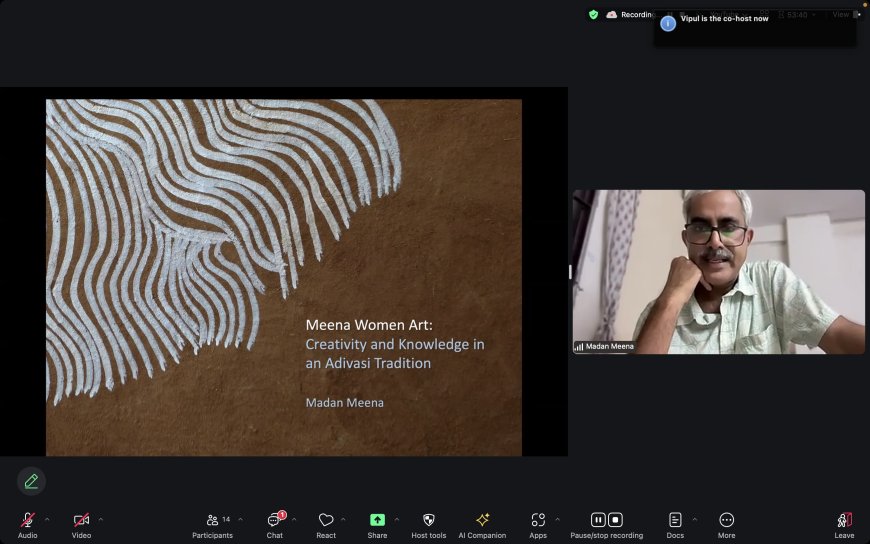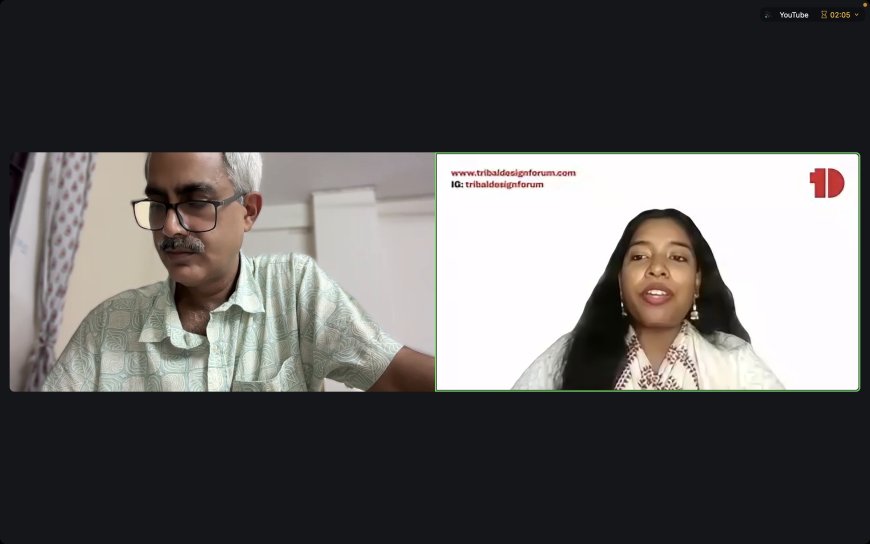Day 4: Craft Practices of Meena Women : Dr. Madan Meena’s Talk at Tribal Futures Fest 2.0
Day 4 of Tribal Futures Fest 2.0 featured a powerful talk by Dr. Madan Meena, focusing on the deep-rooted epistemology behind the art of Meena women in Rajasthan. Drawing from his decades of research, Dr. Meena highlighted how traditional knowledge, gender roles, and visual storytelling come together in Meena wall art and everyday practices. His presentation explored how these indigenous expressions are not merely decorative but represent a form of cultural documentation, resistance, and identity for Meena women. The session emphasized the importance of decolonizing our understanding of folk art, design, and aesthetics, especially within academic and institutional frameworks. The talk resonated with the festival’s core theme of reclaiming indigenous narratives and valuing tribal knowledge systems. This insightful session was a call to recognize and respect tribal women’s contributions to the broader discourse of art, design, and heritage preservation.

At a time when indigenous knowledge systems remain underrepresented in mainstream education, research, and art institutions, Day 2 of Tribal Futures Fest 2.0 featured a session that brought this gap into sharp focus. Dr. Madan Meena’s talk offered a grounded exploration of how Meena women’s traditional wall art—Mandana—is not just a visual practice but an epistemological system in itself. His call for recognizing such embodied knowledge within formal systems set a reflective tone for the ongoing festival.

Screenshot from Day 2 Session of Tribal Futures Fest 2.0, Dr. Madan Meena(left), Host Varsha Mario Kachhap (right).
Introduction of Dr. Madan Meena
Dr. Madan Meena is a researcher, cultural documentarian, and trustee of the Bhasha Research and Publication Centre, Baroda. He formerly served as the Director of Adivasi Academy, Gujarat. His work centers on the Meena community of Rajasthan, focusing on how art, song, and oral traditions reflect indigenous knowledge. In his decades-long research, he has emphasized the importance of documenting Mandana—a traditional wall art created by Meena women—as a living, evolving form of knowledge that challenges colonial and institutional models of understanding art and education.
Key Themes from the Talk
1. Art as Knowledge Transmission
Dr. Meena highlighted that Mandana is not merely decorative but a functional and symbolic system. The motifs encode agricultural patterns, seasons, fertility cycles, and social values—serving as a visual language passed down through generations.
2. Gender and Knowledge Hierarchies
He underlined that women, often left out of written histories, are primary knowledge-bearers in Meena society. The oral and visual transmission through songs, symbols, and designs is a method of knowledge production largely ignored by formal institutions.
3. Participatory Research
Dr. Meena’s approach is not extractive. His fieldwork involves long-term immersion—learning dialects, living among communities, and documenting with consent. This positions research as shared learning, not observation from a distance.
4. Reclaiming Indigenous Epistemology
He advocated for acknowledging that systems like Mandana hold their own logic, meaning, and validation methods. These systems deserve equal recognition alongside academic or written knowledge forms.
Present Status and External Influence
While there has been some institutional interest in Mandana, commercialization and displacement from its rural context have diluted its function. As cemented homes replace mud walls, and urban exhibitions display the art as mere “tribal decor,” its cultural depth risks erasure. NGO interventions, though well-meaning, often miss the embedded values and practices that give the art its meaning. Recognition is growing, but often without community control over narrative or representation.
Problem Area and Call for Action
Dr. Meena pointed out the urgent need to rethink how art and research institutions engage with indigenous knowledge. He called for integrating such knowledge systems into formal curriculum, and for museums and universities to adopt collaborative, community-led approaches. Efforts should focus on sustainability within the original contexts, not just visibility in urban spaces.
Tribal Futures Fest 2.0 is a digital month-long initiative by the Tribal Design Forum showcasing tribal creativity and innovation. It includes talks, presentations, and dialogues by artists, researchers, and practitioners from tribal communities. The fest aims to explore new futures shaped by indigenous voices. It will continue through August with talks, presentations, and discussions highlighting tribal art, film, design, technology, and knowledge systems. The sessions are live streamed on Youtube everyday at 7:00pm. The schedule is available on www.tribaldesignforum.com







